Use of Low-Cost Sensors to Study Atmospheric Particulate Matter Concentrations: Limitations and Benefits Discussed through the Analysis of Three Case Studies in Palermo, Sicily
Abstract
1. Introduction
2. Materials and Methods
2.1. Study Location
2.2. Data Collection
3. Results and Discussion
3.1. Comparison of Temperature and Relative Humidity Measurements
3.2. Comparison between Two Different SDS011 Sensors
3.3. Comparison between PMSA003 and SDS011 Sensors
3.4. The Saharan Sand and Fire Ash Study Case
3.5. The Case Study of New Year’s Eve Fireworks
4. Conclusions
Supplementary Materials
Author Contributions
Funding
Institutional Review Board Statement
Informed Consent Statement
Data Availability Statement
Acknowledgments
Conflicts of Interest
References
- WHO. Available online: https://www.who.int/health-topics/air-pollution (accessed on 14 June 2024).
- Jasarevic, T.; Thomas, G.; Osseiran, N. (March 2014). 7 Million Premature Deaths Annually Linked to Air Pollution. Available online: https://www.who.int/news/item/25-03-2014-7-million-premature-deaths-annually-linked-to-air-pollution (accessed on 14 June 2024).
- Jiang, X.-Q.; Mei, X.-D.; Feng, D. Air pollution and chronic airway diseases: What should people know and do? J. Thorac. Dis. 2016, 8, E31. [Google Scholar] [PubMed]
- Peel, J.L.; Metzger, K.B.; Klein, M.; Flanders, W.D.; Mulholland, J.A.; Tolbert, P.E. Ambient air pollution and cardiovascular emergency department visits in potentially sensitive groups. Am. J. Epidemiol. 2007, 165, 625–633. [Google Scholar] [CrossRef] [PubMed]
- Birnbaum, H.G.; Carley, C.D.; Desai, U.; Ou, S.; Zuckerman, P.R. Measuring the impact of air pollution on health care costs: Study examines the impact of air pollution on health care costs. Health Aff. 2020, 39, 2113–2119. [Google Scholar] [CrossRef] [PubMed]
- Motlagh, N.H.; Zaidan, M.A.; Fung, P.L.; Lagerspetz, E.; Aula, K.; Varjonen, S.; Siekkinen, M.; Rebeiro-Hargrave, A.; Petäjä, T.; Matsumi, Y.; et al. Transit pollution exposure monitoring using low-cost wearable sensors. Transp. Res. Part D: Transp. Environ. 2021, 98, 102981. [Google Scholar] [CrossRef]
- Gao, Y.; Dong, W.; Guo, K.; Liu, X.; Chen, Y.; Liu, X.; Bu, J.; Chen, C. Mosaic: A low-cost mobile sensing system for urban air quality monitoring. In Proceedings of the IEEE INFOCOM 2016-the 35th Annual IEEE International Conference on Computer Communications, San Francisco, CA, USA, 10–14 April 2016; pp. 1–9. [Google Scholar]
- Saha, D.; Shinde, M.; Thadeshwar, S. Iot-based air quality monitoring system using wireless sensors deployed in public bus services. In Proceedings of the Second International Conference on Internet of things, Data and Cloud Computing (ICC ’17). Association for Computing Machinery, Cambridge, UK, 22–23 March 2017; Association for Computing Machinery: New York, NY, USA Article 87. ; pp. 1–6. [Google Scholar] [CrossRef]
- Carotenuto, F.; Bisignano, A.; Brilli, L.; Gualtieri, G.; Giovannini, L. Low-cost air quality monitoring networks for long-term field campaigns: A review. Meteorol. Appl. 2023, 30, e2161. [Google Scholar] [CrossRef]
- Gualtieri, G.; Brilli, L.; Carotenuto, F.; Cavaliere, A.; Giordano, T.; Putzolu, S.; Vagnoli, C.; Zaldei, A.; Gioli, B. Performance Assessment of Two Low-Cost PM2.5 and PM10 Monitoring Networks in the Padana Plain (Italy). Sensors 2024, 24, 3946. [Google Scholar] [CrossRef] [PubMed]
- Bi, J.; Carmona, N.; Blanco, M.N.; Gassett, A.J.; Seto, E.; Szpiro, A.A.; Larson, T.V.; Sampson, P.D.; Kaufman, J.D.; Sheppard, L. Publicly available low-cost sensor measurements for PM2.5 exposure modeling: Guidance for monitor deployment and data selection. Environ. Int. 2022, 158, 106897. [Google Scholar] [CrossRef] [PubMed]
- EPA. Available online: https://www.epa.gov/pm-pollution/health-and-environmental-effects-particulate-matter-pm (accessed on 14 June 2024).
- Nyhan, M.; McNabola, A.; Misstear, B. Comparison of particulate matter dose and acute heart rate variability response in cyclists, pedestrians, bus and train passengers. Sci. Total Environ. 2014, 468, 821–831. [Google Scholar] [CrossRef] [PubMed]
- Yin, W.; Hou, J.; Xu, T.; Cheng, J.; Wang, X.; Jiao, S.; Wang, L.; Huang, C.; Zhang, Y.; Yuan, J. Association of individual-level concentrations and human respiratory tract deposited doses of fine particulate matter with alternation in blood pressure. Environ. Pollut. 2017, 230, 621–631. [Google Scholar] [CrossRef] [PubMed]
- Comune di Palermo. Available online: https://www.comune.palermo.it/js/server/uploads/statistica/_20032023131630.pdf (accessed on 14 June 2024).
- Catalano, R.; Agate, M.; Albanese, C.; Avellone, G.; Basilone, L.; Gasparo Morticelli, M.; Gugliotta, C.; Sulli, A.; Valenti, V.; Gibilaro, C.; et al. Walking along a crustal profile across the Sicily Fold and Thrust Belt. In Proceedings of the AAPG International Conference & Exhibition, Milan, Italy, 23–26 October 2011; Post-Conference Field Trip 4, Palermo, Italy, 27–29 October 2011. pp. 61–78. [Google Scholar] [CrossRef]
- Kelly, K.E.; Whiaker, J.; Petty, A.; Widmer, C.; Dybwad, A.; Sleeth, D.; Martin, R.; Butterfield, A. Ambient and laboratory evaluation of a low-cost particulate matter sensor. Environ. Pollut. 2017, 221, 491–500. [Google Scholar] [CrossRef] [PubMed]
- Air Quality Sensor Performance Evaluation Center. 2017 Field Laboratory Evaluation Report for PurpleAir, P.A.-I.I. Available online: http://www.aqmd.gov/docs/default-source/aq-spec/field-evaluations/purple-air-pa-ii---field-evaluation.pdf (accessed on 14 June 2024).
- Budde, M.; Schwarz, A.; Müller, T.; Laquai, B.; Streibl, N.; Schindler, G.; Riedel, T.; Dittler, A.; Beigl, M. Potential and Limitations of the Low-Cost SDS011 Particle Sensor for Monitoring Urban Air Quality. In Proceedings of the 3rd International Conference on Atmospheric Dust - DUST2018, Bari, Italy, 28-31 May 2018. [Google Scholar] [CrossRef]
- Liu, H.-Y.; Schneider, P.; Haugen, R.; Vogt, M. Performance Assessment of a Low-Cost PM2.5 Sensor for a near Four-Month Period in Oslo, Norway. Atmosphere 2019, 10, 41. [Google Scholar] [CrossRef]
- Laser PM2.5 Sensor Specification Product Model: SDS011, Version: V1.3. Available online: https://nettigo.pl/attachments/398> (accessed on 14 June 2024).
- GP2Y1010AU0F: Compact Optical Dust Sensor. Available online: https://www.sparkfun.com/datasheets/Sensors/gp2y1010au_e.pdf (accessed on 14 June 2024).
- Genikomsakis, K.N.; Galatoulas, F.K.; Dallas, P.I.; Ibarra, L.M.C.; Margaritis, D.; Ioakimidis, C. Development and On-Field Testing of Low-Cost Portable System for Monitoring PM2.5 Concentrations. Sensors 2018, 18, 1056. [Google Scholar] [CrossRef] [PubMed]
- Božilov, A.; Tasić, V.; Živković, N.; Lazović, I.; Blagojević, M.; Misić, N.; Topalović, D. Performance assessment of NOVA SDS011 low-cost PM sensor in various microenvironments. Environ. Monit. Assess. 2022, 194, 595. [Google Scholar] [CrossRef] [PubMed]
- Prodata Weather Systems. Available online: https://davisenviromonitors.com/davis-airlink/ (accessed on 14 June 2024).
- AQMD. Available online: https://www.aqmd.gov/aq-spec/sensordetail/davis-instruments---airlink (accessed on 14 June 2024).
- Sensirion SHT30. Available online: https://sensirion.com/products/catalog/SHT30-DIS-B/ (accessed on 9 July 2024).
- Sensirion SHT31. Available online: https://sensirion.com/products/catalog/SHT31-DIS-B/ (accessed on 9 July 2024).
- WMO Guide to Meteorological Instruments and Methods of Observation (WMO-No. 8). Available online: https://community.wmo.int/en/activity-areas/imop/wmo-no_8 (accessed on 9 July 2024).
- Davis Instruments Corporation “Vantage Pro2”. Available online: https://www.davisinstruments.com/pages/vantage-pro2 (accessed on 9 July 2024).
- Laquai, B.; Saur, A. Development of a Calibration Methodology for the SDS011 Low-Cost PM-Sensor with respect to Professional Reference Instrumentation. 2017. Available online: https://www.researchgate.net/publication/322628807_Development_of_a_Calibration_Methodology_for_the_SDS011_Low-Cost_PM-Sensor_with_respect_to_Professional_Reference_Instrumentation (accessed on 10 August 2024).
- Palermo Today. Available online: https://www.palermotoday.it/cronaca/viale-regione-incendi-22-settembre-2023.html (accessed on 11 September 2024).
- EFFIS. Available online: https://forest-fire.emergency.copernicus.eu/ (accessed on 11 September 2024).
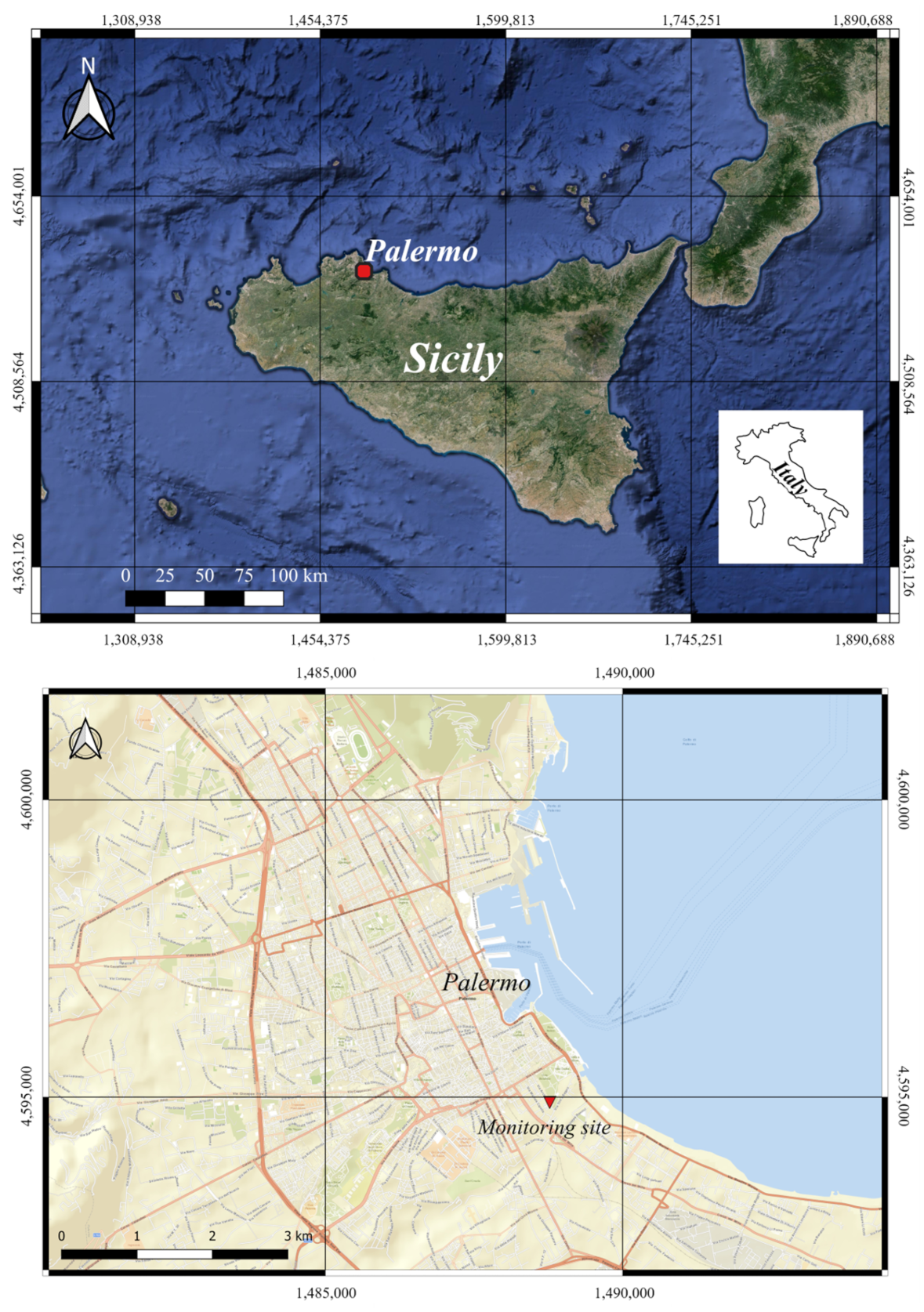


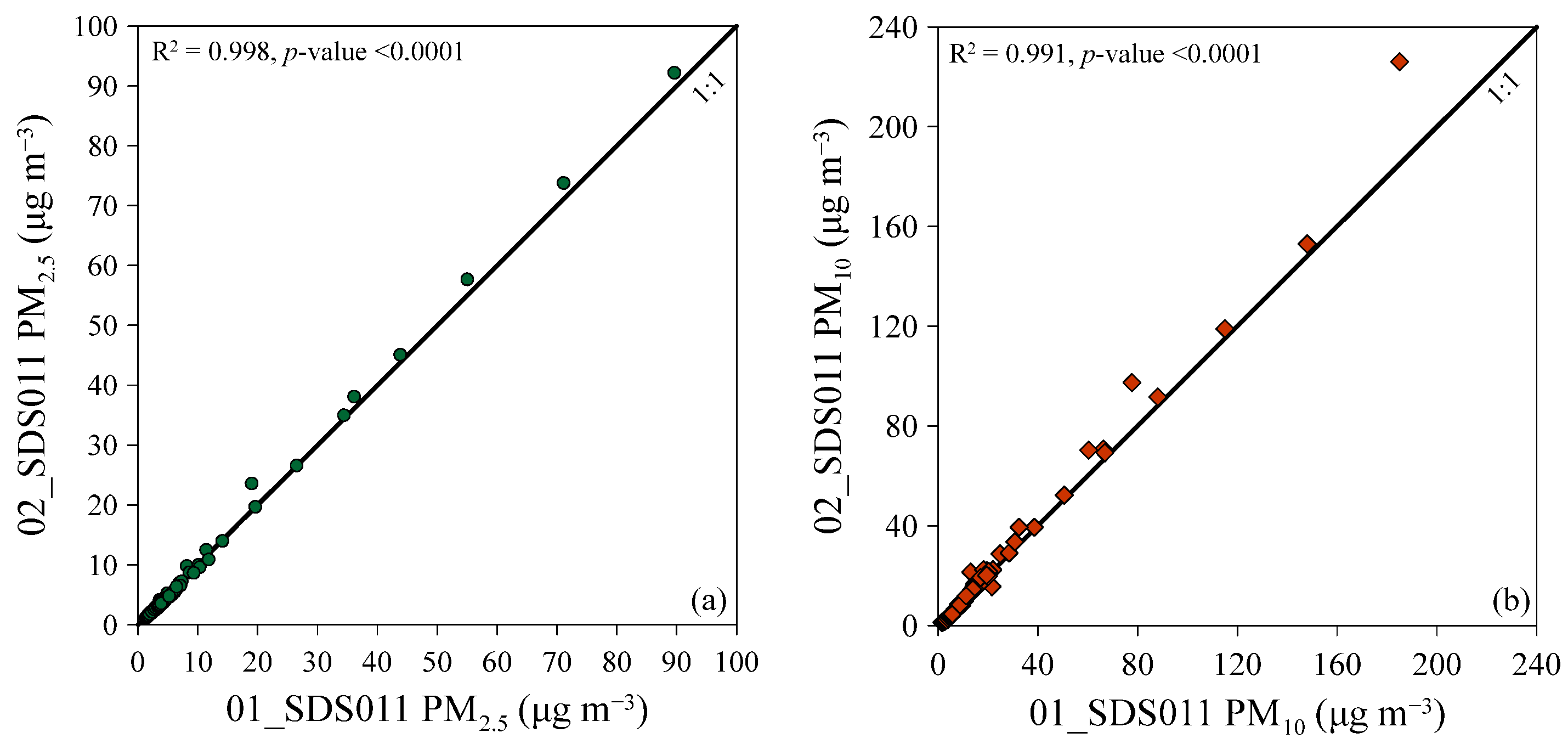
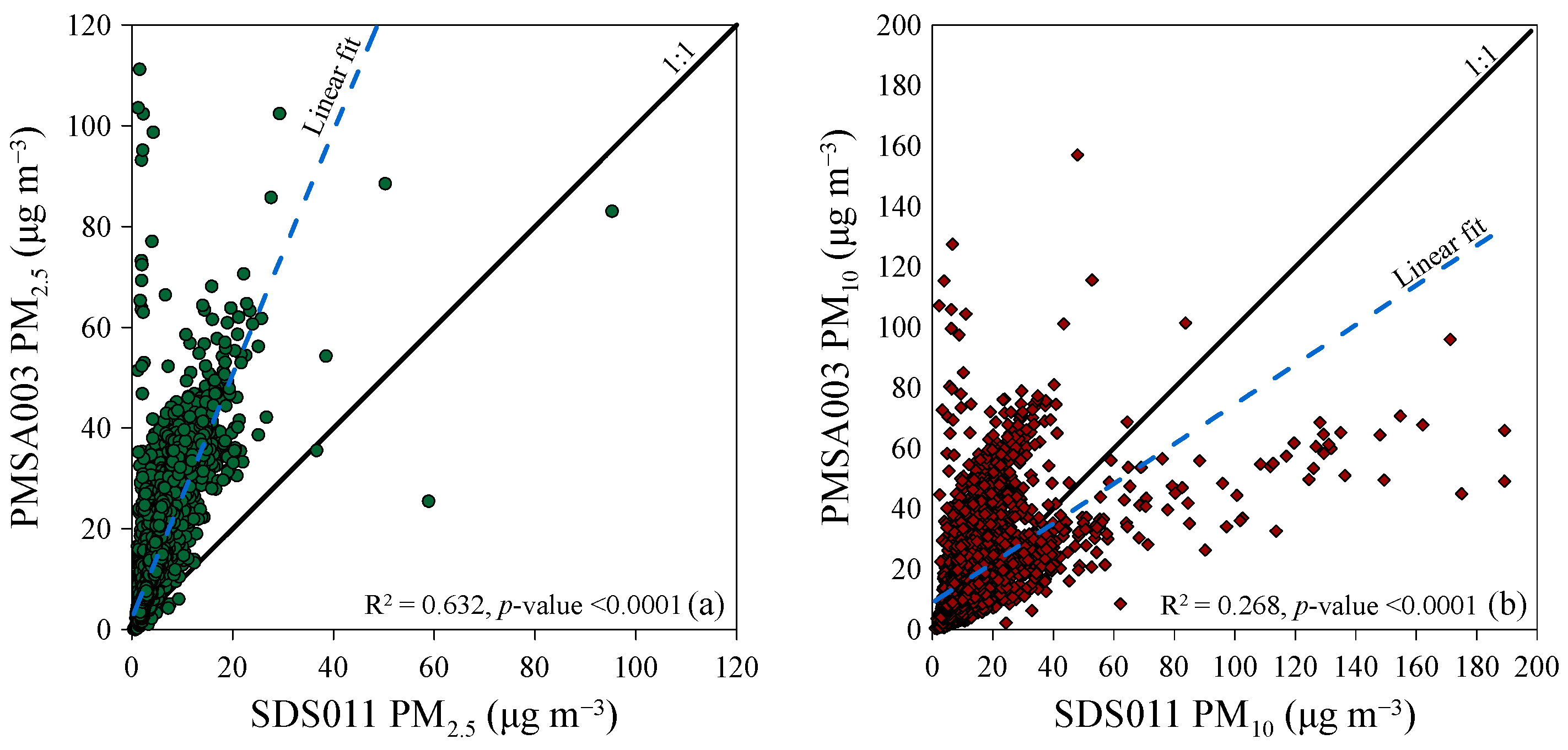
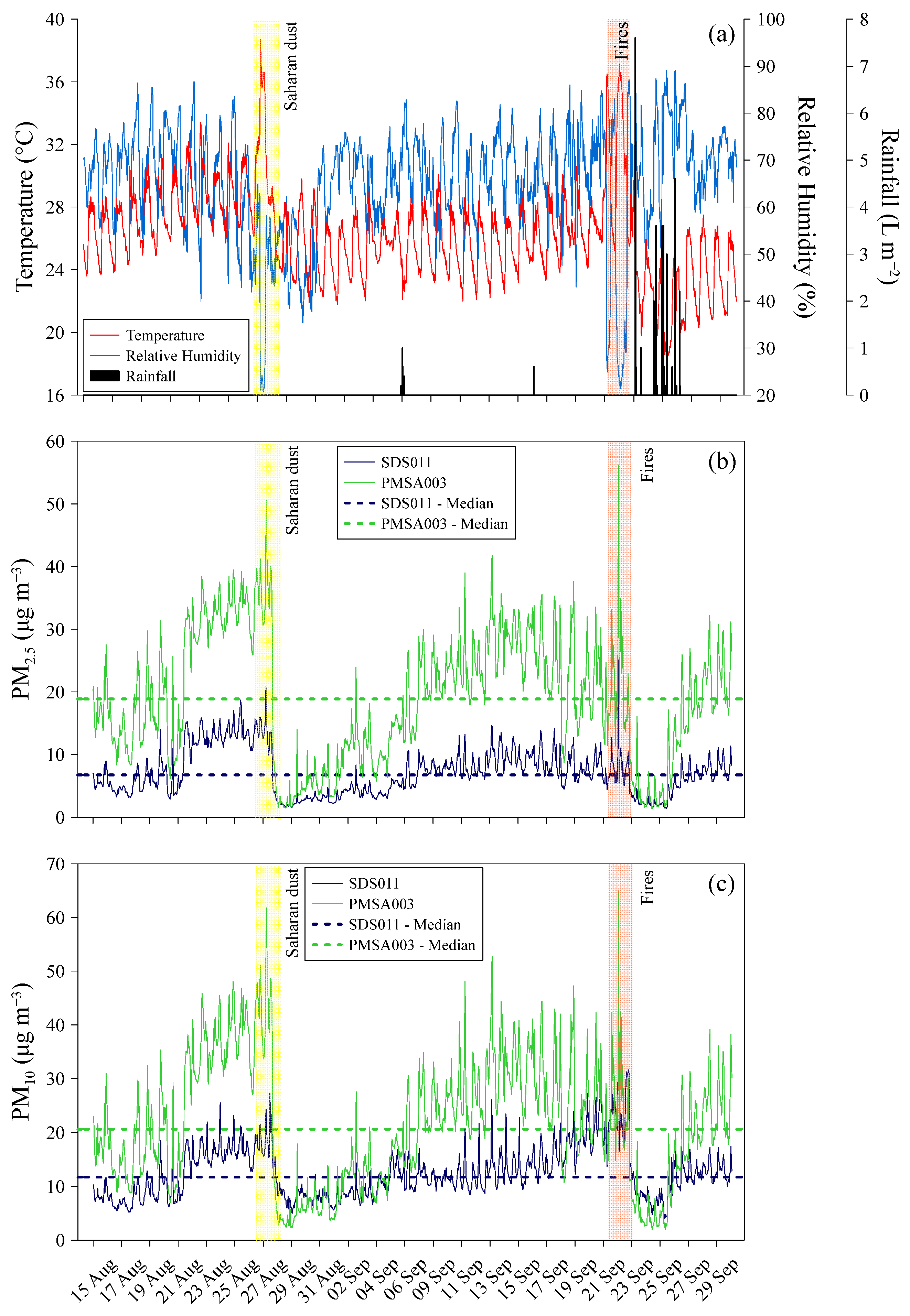
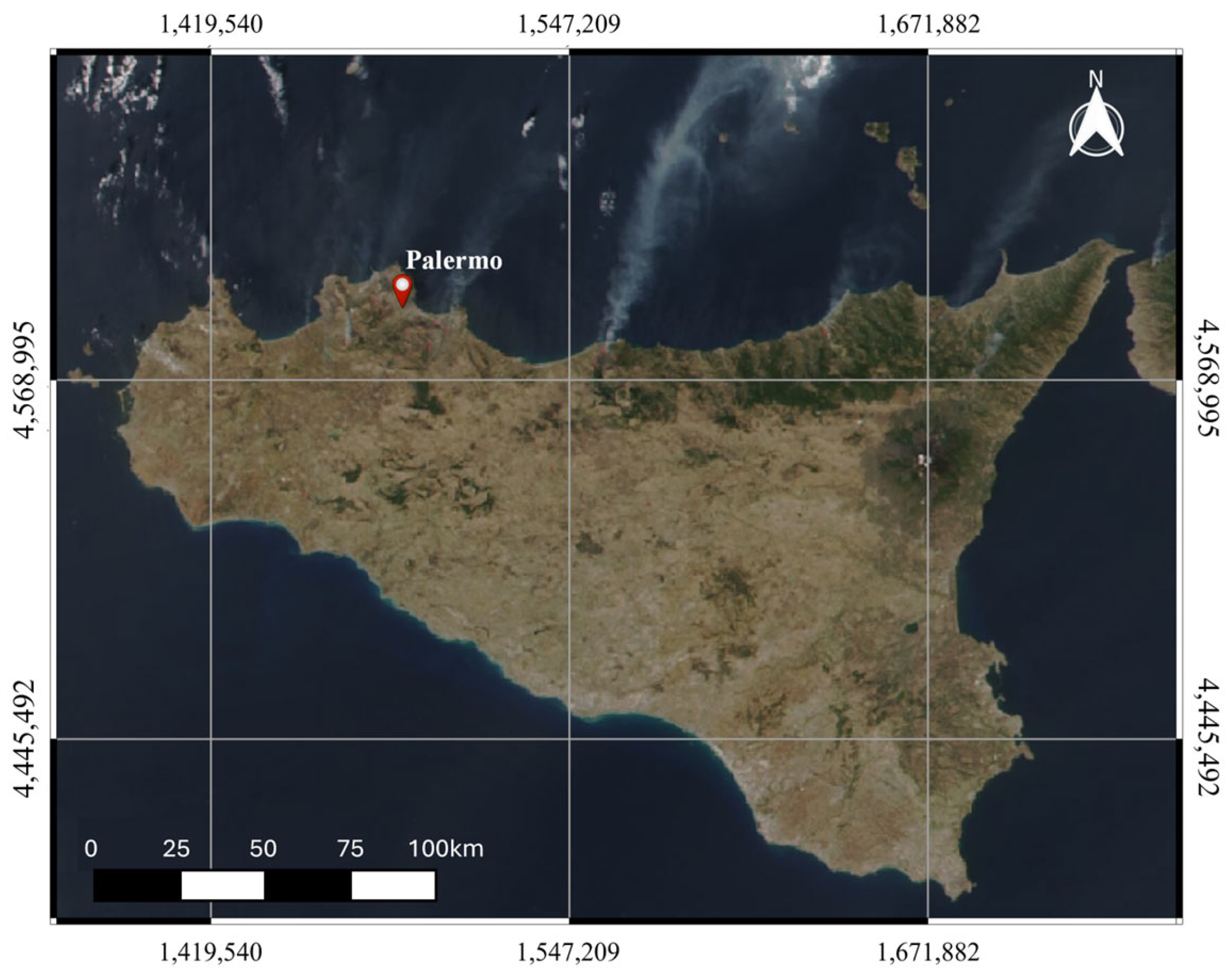
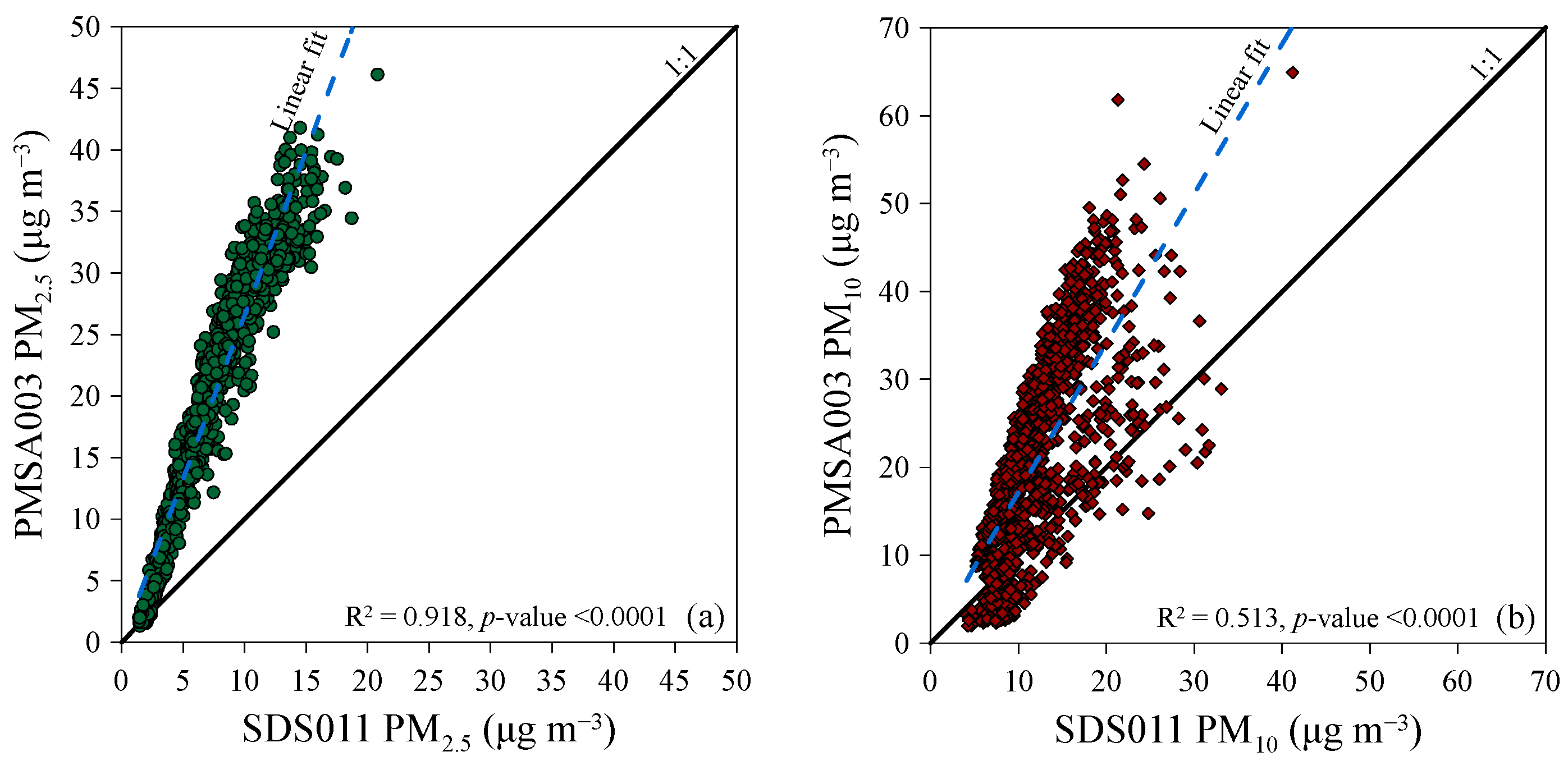
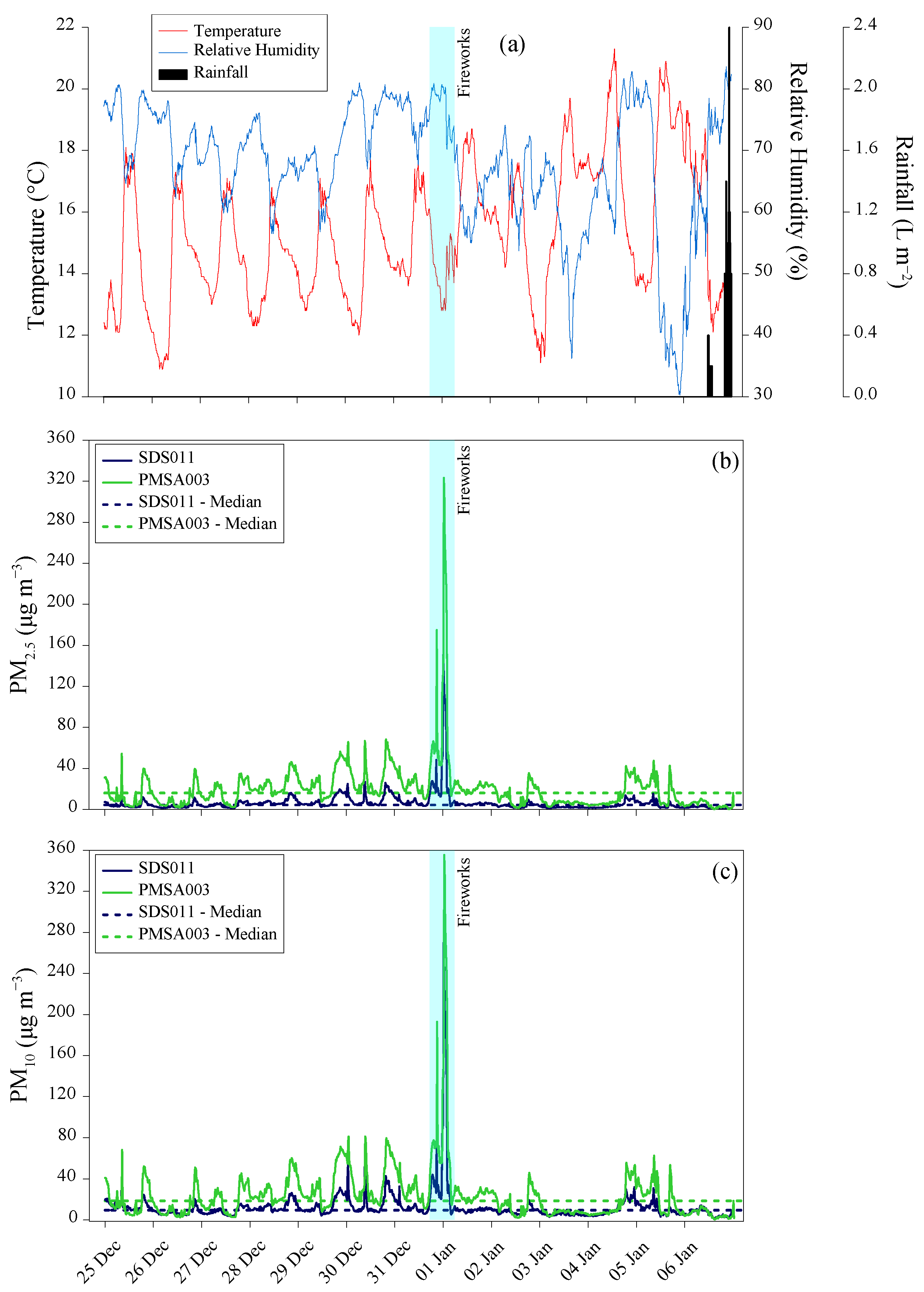

Disclaimer/Publisher’s Note: The statements, opinions and data contained in all publications are solely those of the individual author(s) and contributor(s) and not of MDPI and/or the editor(s). MDPI and/or the editor(s) disclaim responsibility for any injury to people or property resulting from any ideas, methods, instructions or products referred to in the content. |
© 2024 by the authors. Licensee MDPI, Basel, Switzerland. This article is an open access article distributed under the terms and conditions of the Creative Commons Attribution (CC BY) license (https://creativecommons.org/licenses/by/4.0/).
Share and Cite
Brugnone, F.; Randazzo, L.; Calabrese, S. Use of Low-Cost Sensors to Study Atmospheric Particulate Matter Concentrations: Limitations and Benefits Discussed through the Analysis of Three Case Studies in Palermo, Sicily. Sensors 2024, 24, 6621. https://doi.org/10.3390/s24206621
Brugnone F, Randazzo L, Calabrese S. Use of Low-Cost Sensors to Study Atmospheric Particulate Matter Concentrations: Limitations and Benefits Discussed through the Analysis of Three Case Studies in Palermo, Sicily. Sensors. 2024; 24(20):6621. https://doi.org/10.3390/s24206621
Chicago/Turabian StyleBrugnone, Filippo, Luciana Randazzo, and Sergio Calabrese. 2024. "Use of Low-Cost Sensors to Study Atmospheric Particulate Matter Concentrations: Limitations and Benefits Discussed through the Analysis of Three Case Studies in Palermo, Sicily" Sensors 24, no. 20: 6621. https://doi.org/10.3390/s24206621
APA StyleBrugnone, F., Randazzo, L., & Calabrese, S. (2024). Use of Low-Cost Sensors to Study Atmospheric Particulate Matter Concentrations: Limitations and Benefits Discussed through the Analysis of Three Case Studies in Palermo, Sicily. Sensors, 24(20), 6621. https://doi.org/10.3390/s24206621






